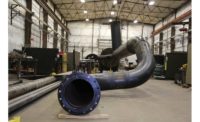When Gordon Lansford became the first non-Dunn family member to serve as CEO of Kansas City, Mo.-based JE Dunn in 2013, he promised to create a more inclusive, engaged construction company while continuing a transition that began under previous President and CEO Steve Dunn to move the company more toward employee ownership. Lansford’s made progress on that goal, with JE Dunn now 20% owned by its employees and 80% by the Dunn family.
This is the first year that ENR’s Midwest Top Contractors survey included work from the states of Iowa, Kansas, Kentucky, Minnesota and Nebraska. That expansion provides a more accurate picture of the 93-year-old general contractor’s regional work than in years past—and adds $935.6 million to its total regional revenue. Adding Kansas to the mix added $522 million alone, lifting the firm’s total Midwest revenue to $1.3 billion and catapulting the firm to fifth place on this year’s Midwest Top Contractors list from No. 22 in 2016.
The expanded geographic range also brought into focus 342,000 square miles of work from states previously uncounted in the region. Even if the expansion had not happened, JE Dunn still would have expanded its revenue to $377.2 million this year in Illinois, Indiana, Michigan, Missouri, Ohio and Wisconsin, compared with $349.3 million for the previous year, an 8% increase in the “old” Midwest region. The expanded regional range offers a more accurate picture of the firm’s work and shows just how much of a regional and national player—with $3.2 billion in total revenue—JE Dunn has become. Lansford says the transformation to a more engaged corporate culture is responsible for that success.
“One of my challenges was to make our company more attractive (to) young people,” Lansford says. “We have done a lot of tweaking of the culture. We went from a command-and-control type of culture to one of trust and accountability. We try to explain to our employee-owners what we are doing, why we are doing it and what their role is and what success looks like for them as employees of the company and as employee-owners. We are giving them a level of trust and empowering them to find a better way to do things but also holding them accountable for the results.”
Top Tech Contractor
The transition is ongoing. and it hasn’t always been easy. John Jacobs, chief innovation officer, has led the company’s embrace of construction-side technology and has been responsible for the development of tools such as Dunn Dashboard, the company’s extranet-based project accounting and estimation tool that Jacobs calls a “single source of truth” for model-based cost information on more than 400 JE Dunn projects.
“We see our technology commitment as a huge differentiator,” Lansford says. “We also recognize that differentiators have a shelf life. People are close behind us. We are looking for what is that next differentiator with an eye on building faster, better, cheaper. That’s what our clients want.”
Another in-house-developed tool, JE Dunn Lens, creates a data layer on top of an architect’s Revit model and has been used on more than 30 JE Dunn projects to show clients and design professionals exactly what changes will cost and how they will affect estimates and budgets.
A visual look at how design changes affect a project at the earliest stages can create a better relationship between architect and contractor, Jacobs says. Development of Lens required staff from Jacobs’ 36-person team to work with Autodesk and Microsoft programmers to create the tool and integrate it with Revit.
“A lot of the technology and process advances are on the front side, design planning and collaboration,” Lansford says. “We have to find a way to better use technology for … the actual construction of our projects. It’s not just technology, either, it’s means and methods. We all talk about lean construction, prefabrication and the like. We and other leaders in our industry have to figure out ways to make that talk reality because the labor shortage is only going to get worse.”
JE Dunn has undertaken initiatives to train, retain and empower skilled labor, but Lansford says he would like to make more progress on the people side of the equation. He explains that the contractor is interested in working with trade partners who think more like manufacturers and builders and take prefabrication and lean construction to a higher level than is currently possible on most projects.
Careers in Construction
JE Dunn has made its health care plans accessible sooner for skilled labor across the organization, and a small change, giving every worker who gets a paycheck a company email address and access to an intranet portal, met with strong positive feedback from workers.
“We plan to grow that focus on the workforce across the entire organization,” Lansford says. “With the labor shortage, those that have the labor are going to win. We found that communicating through supervisors or representatives on the job is just not the same as having that ability to communicate individually.”
That focus also means communicating more often with clients using tools such as Lens and Dunn Dashboard. The contractor used its Lens tool on the first phase of a 12-year master plan for the new headquarters of Kansas City-based Cerner Corp., a provider of health care technology services.
Features of Cerner’s Innovations Campus designed by architect Gould Evans reflect the company’s values and the health care information technology industry itself. The facility’s windows were modeled after the double-helix structure associated with strands of human DNA.
“Neighborhood nodes” within the office spaces each feature their own personalities to help software engineers focus, innovate and create better solutions. Various features in the nodes include a library, gaming area, think tank and maker space for more hands-on creative pursuits.
JE Dunn’s project team used Lens in collaboration with Cerner executives to visualize cost impacts by creating a visual tie between the estimate and the virtual model.
“It has been my pleasure working with (JE Dunn) and we couldn’t have pulled it off without their willingness to be flexible,” says Mike Nill, executive vice president and COO of Cerner.
Both office and government/public service buildings were strong markets for JE Dunn. The $310-million restoration of the Minnesota State Capitol, set to reopen in August, was a particularly difficult historic preservation challenge. The building is on the National Register of Historic Places but suffered from serious water damage in its lower areas. It also needed a new roof, exterior repairs and restoration work of its interior marble and plaster that would preserve the features of the 1905 Cass Gilbert design. The lack of skilled local subcontractors came into play on the project. This is where Lansford sees better construction technology and collaboration with trade contractors helping on future projects.
“We have done prefabrication but we want to look at other areas where we can do it even more—where our trade partners can take more of their scope of work off site, integrate their technology and their lean means and methods with ours,” Lansford says. “We see a lot of value to our clients in working with really forward-thinking trade partners.”
Going forward, Lansford sees the company keeping its traditional values but also adapting to new methods of communication and construction delivery.
“Our strategic direction hasn’t changed but we are further into the process and we are starting to see more benefit from it,” Lansford says. “Three generations of Dunn family leadership built a great company based in our core values—particularly integrity, caring for our people, doing the right thing and investing in our communities. That will always be part of who we are. We are tweaking that culture, not changing it.













Post a comment to this article
Report Abusive Comment